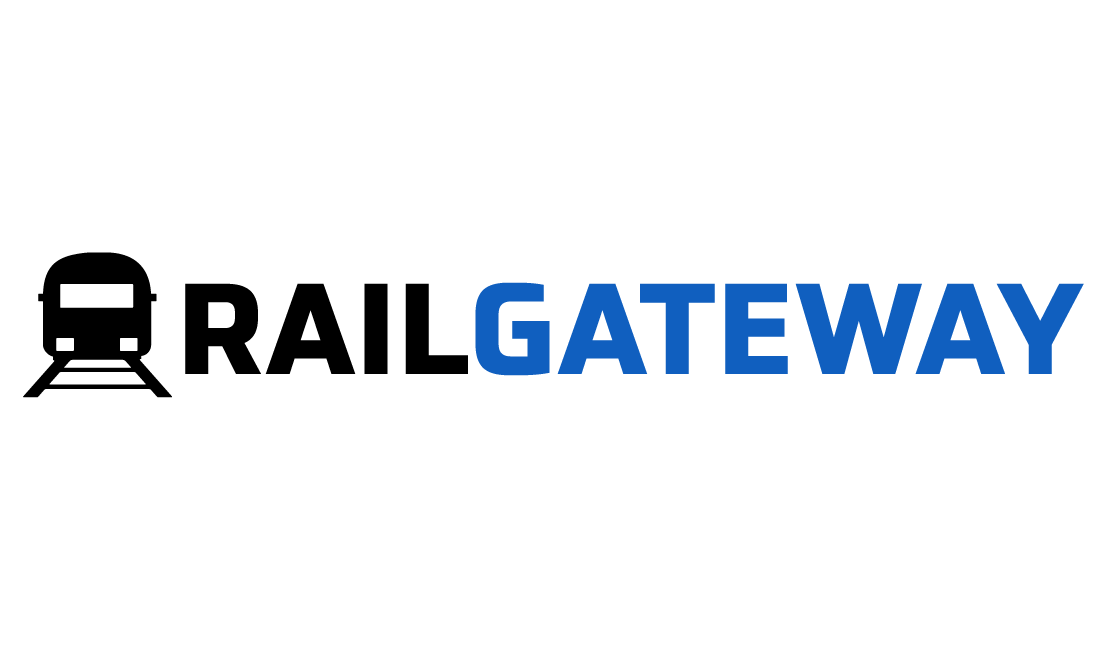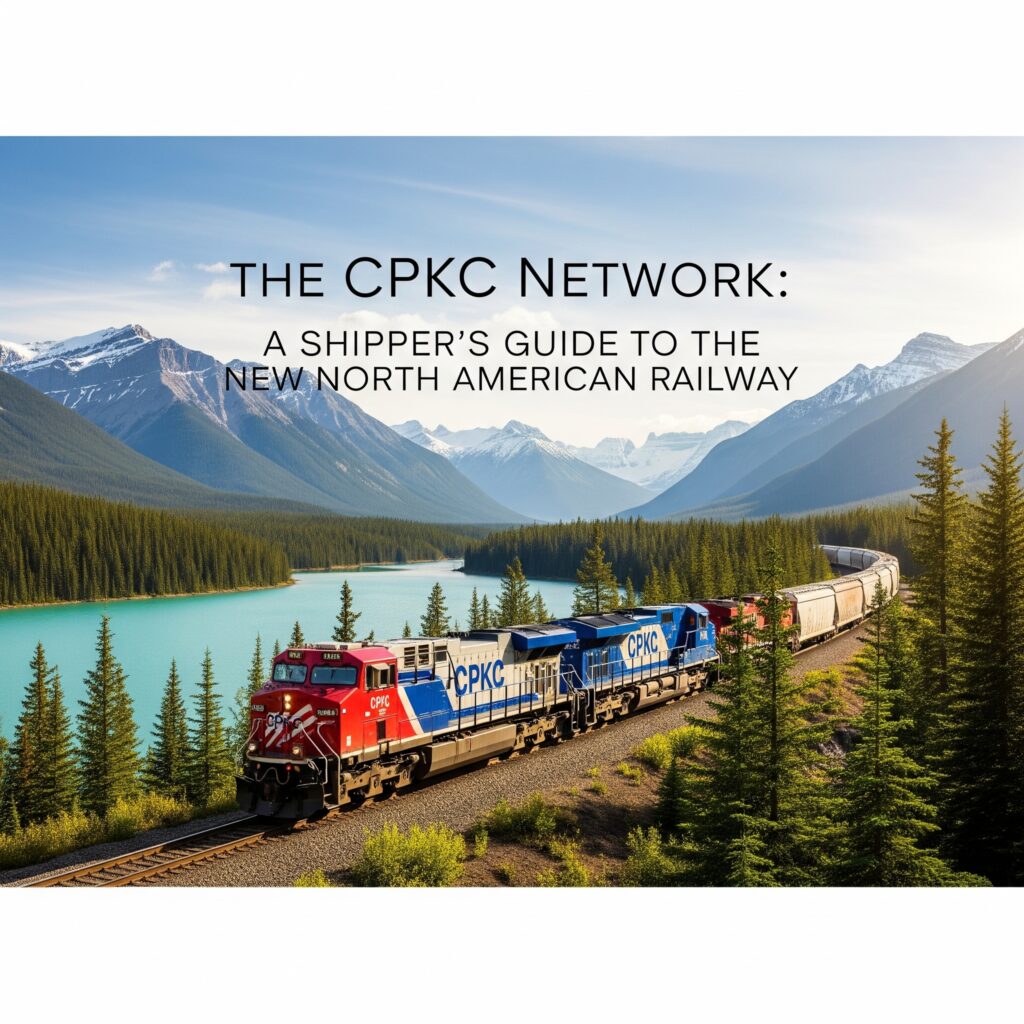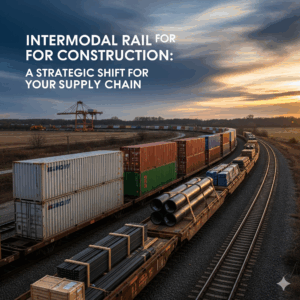For the first time in history, a single, unbroken railway line stretches from the shores of Vancouver to the heart of Mexico, connecting the industrial centers of three nations. This is the new reality of North American logistics, forged by the historic merger of Canadian Pacific (CP) and Kansas City Southern (KCS) to create the CPKC network.
This isn’t just a corporate merger; it’s a fundamental redrawing of the continent’s supply chain map. It creates new efficiencies, opens previously non-existent direct routes, and offers businesses a powerful new tool to move goods seamlessly across Canada, the United States, and Mexico.
But what does this new railway powerhouse actually mean for your business? Where does it go, what can it do, and how can you leverage its unique advantages?
Consider this your definitive starting point. This guide will demystify the new CPKC network. We’ll map out its strategic reach, explain the game-changing benefits of its single-line service, and break down the core freight services it offers to shippers across North America.
A New Map for North America: The CPKC Network Advantage
Before this merger, a shipment moving from Canada to Mexico would have to be “interchanged” – handed off from one railway to another at a border or major hub. Each interchange was a point of potential delay, added cost, and logistical complexity.
The CPKC network eliminates this entirely. Its primary advantage is single-line service, meaning a container can be loaded onto a train in Montreal and travel all the way to Monterrey, Mexico, on a single railway, under the control of a single operator.
This integrated system provides three game-changing benefits:
- Increased Speed and Efficiency: By eliminating interchanges, transit times are significantly reduced. Goods spend less time sitting in congested rail yards and more time moving toward their destination.
- Enhanced Reliability and Visibility: With one carrier responsible for the entire journey, there is a single source of truth for tracking and a higher degree of accountability. This leads to more predictable and reliable supply chains.
- Simplified Cross-Border Logistics: While customs procedures still apply, managing them through a single, coordinated carrier network is far simpler than juggling multiple railways and their disparate processes.

Tracing the Key Routes of the CPKC Network
The true power of the CPKC network lies in its strategic routes connecting major industrial, agricultural, and maritime hubs across three nations. Let’s trace its path and the unique role of its key hubs.
- The Canadian Foundation & Pacific Gateway: The network is anchored by CP’s historic trans-Canadian mainline, stretching from the vital Port of Vancouver. For decades, this has been North America’s closest major port to Asia. With the CPKC merger, its role is amplified. Goods arriving from across the Pacific now have a direct, single-line route not just across Canada, but deep into the US Midwest and, for the first time, all the way to Mexico, bypassing traditional congestion points on the U.S. West Coast. The network also spans east through resource-rich hubs like Calgary and into the industrial heartlands of Toronto and Montreal.
- The U.S. Midwest Corridor & The “Heart” of the Network: From Canada, the network dives into the bustling U.S. Midwest, centered around the critical rail hub of Kansas City, MO. This is the strategic nexus – the literal “beating heart” – of the entire system where the former CP and KCS networks merge. It is the central nervous system for all North-South traffic, providing connections to other railways and serving as the primary consolidation point for goods moving between the three countries.
- The U.S. Gulf Coast & The Laredo Border: The network extends south from Kansas City through key markets like Dallas/Fort Worth to major Gulf of Mexico ports in Houston, TX, and New Orleans, LA. It also funnels to the single most important cross-border rail point in North America: Laredo, TX. The single-line service through Laredo is a game-changer, designed to streamline operations and reduce transit times at this traditionally congested gateway.
- The Mexican Powerhouse: This is where the CPKC network becomes truly unique. After crossing at Laredo, the line extends deep into Mexico’s booming manufacturing region. It directly serves industrial cities like Monterrey and San Luis Potosí, which are epicenters of automotive and appliance manufacturing. Crucially, the network also reaches major ports like Lázaro Cárdenas on the Pacific and Veracruz on the Gulf, providing Mexican businesses with unprecedented single-line access to consumer markets across the U.S. and Canada.
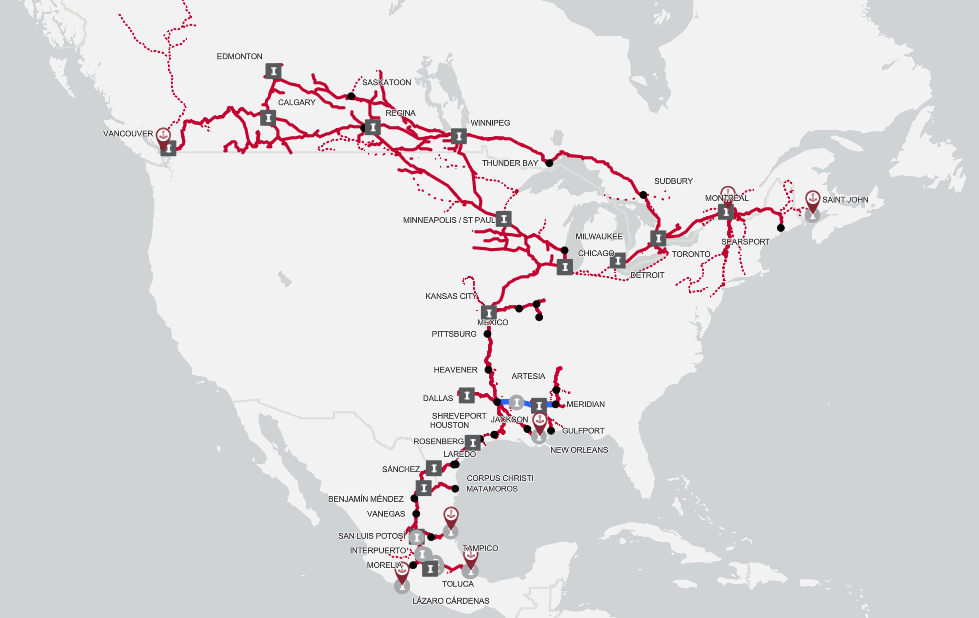
Core Freight Services on the CPKC Network
The CPKC network is a versatile system built to transport a wide array of goods. The services offered are tailored to the specific needs of different industries, now enhanced by the new tri-national reach.
1. Intermodal Shipping (Containers)
This service is the backbone of the retail and consumer goods supply chain, involving the seamless movement of standard shipping containers (53′, 40′, 20′) by both truck and train. The CPKC merger has supercharged this offering. For example, a Canadian food producer can now load a temperature-controlled reefer container in Toronto and ship their goods directly to a growing consumer market in Mexico City with unprecedented speed and end-to-end visibility. It’s the ideal solution for moving finished merchandise, electronics, apparel, and food products efficiently across the continent.
2. Automotive Shipping
The CPKC network is now arguably the most vital railway for the highly integrated North American automotive industry. A single vehicle may have its engine block cast in Mexico, its transmission assembled in the U.S., and its final assembly completed in Ontario. Using enclosed, multi-level “auto-rack” rail cars, the CPKC network provides a direct, “factory-floor-to-showroom-floor” artery that perfectly mirrors this complex, just-in-time supply chain, moving thousands of finished vehicles and auto parts daily without risky and time-consuming interchanges.
3. Bulk and Carload Shipping
This service remains essential for moving the raw materials that fuel all three economies. It utilizes specialized rail cars for specific commodities, with the new network opening up new markets.
- Grain Hoppers: Now, Canadian grain from the Prairies has a more direct and efficient path not just to ports for overseas export, but also to feed mills and processors in the southern U.S. and Mexico.
- Tank Cars: A direct line for moving petroleum products from the energy sectors in Alberta and Texas to industrial consumers across the continent.
- Potash Cars: A seamless route for transporting essential fertilizer from mines in Saskatchewan to agricultural communities deep into the U.S. and Mexico.
Who Benefits Most from the New CPKC Network?
While the entire North American economy benefits from a more efficient railway, several types of businesses are uniquely positioned to gain a competitive advantage by leveraging the new CPKC network.
The Cross-Border Manufacturer Consider an automotive parts manufacturer in Monterrey, Mexico. They need to supply components to an assembly plant in Windsor, Ontario, on a strict just-in-time schedule. Previously, their shipment would have to be interchanged between at least two, possibly three, different railways, with each handoff introducing risk and potential delays. Today, they can load a container onto a single CPKC train and have it travel on one seamless, accountable network all the way to its destination, dramatically increasing reliability and reducing inventory costs.
The Canadian Agricultural Exporter Imagine a company in Saskatchewan that produces high-quality lentils and grains. Their primary export markets used to be overseas via the Port of Vancouver. With the new CPKC network, they now have a direct, efficient rail route to sell their products to a massive new market of food processors and distributors in Mexico, creating a significant new revenue stream that was previously logistically challenging and cost-prohibitive to service effectively.
The U.S. Retail Importer Think of a large U.S. retailer based in Dallas that imports consumer goods from Asia. They can now redirect their shipments to the less congested Port of Vancouver and take advantage of CPKC’s direct single-line service south. This allows them to bypass potential bottlenecks at U.S. West Coast ports and establish a faster, more predictable supply chain to stock their distribution centers and stores throughout the central and southern United States.
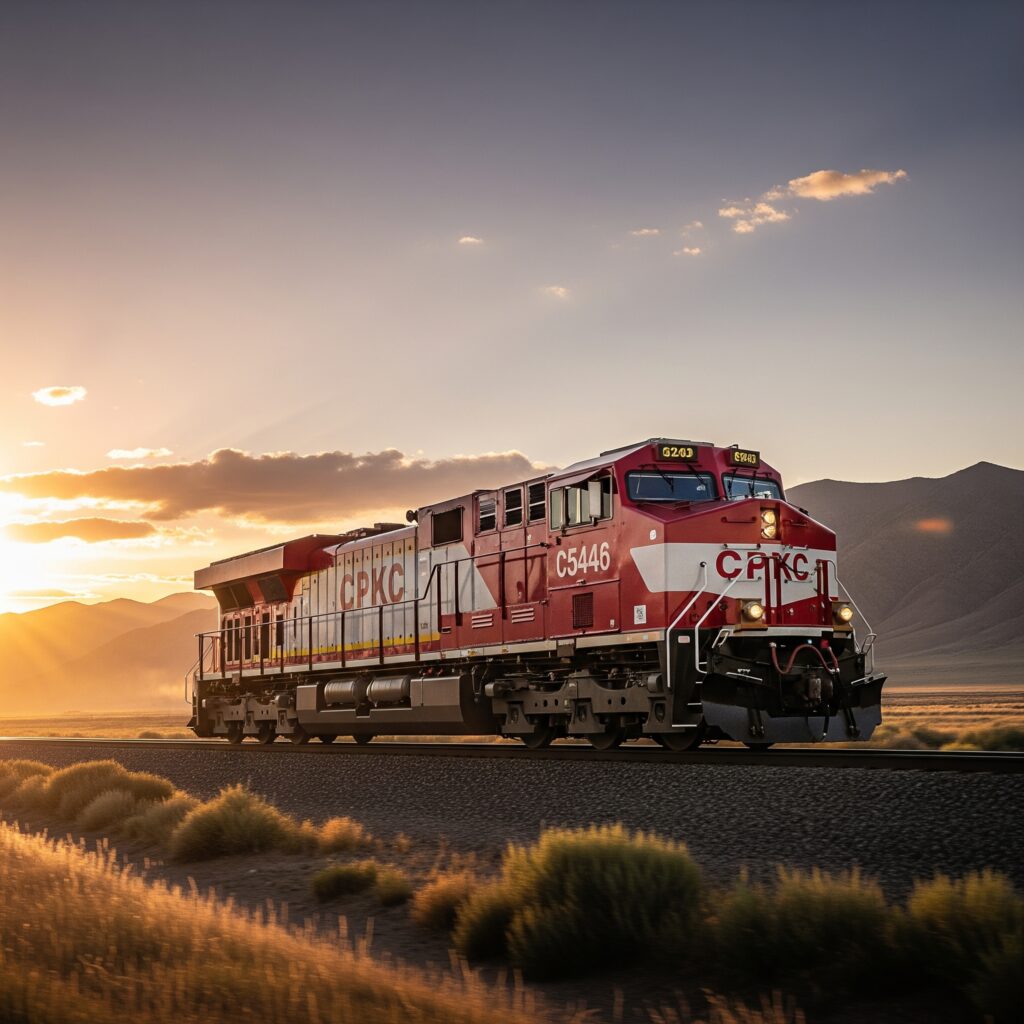
The Strategic Implications for Your Business
The creation of the CPKC network isn’t just news for logistics nerds; it’s a strategic opportunity for businesses of all sizes. It allows you to:
- Source from New Markets: Canadian companies can now build more resilient supply chains by sourcing materials directly from manufacturing centers in Mexico.
- Reach New Customers: U.S. and Canadian businesses have a more direct and efficient path to sell their products to Mexico’s growing consumer market.
- Increase Supply Chain Velocity: By using a faster, more reliable single-line service, you can reduce inventory carrying costs and get your products to market quicker.
Conclusion: From Knowledge to Strategy
Having journeyed from the strategic Pacific ports of Vancouver and Prince Rupert, across the industrial heartland, and down to the Gulf of Mexico, you now possess a comprehensive map of the CPKC Rail network. You understand its critical role as a backbone for North American trade and can distinguish between its core services, whether you’re shipping a single intermodal container or an entire train of bulk commodities.
This foundational knowledge is invaluable. However, understanding the ‘what’ and ‘where’ of the network is only the first half of the equation. The most critical question for your business remains: how do you most effectively and efficiently tap into this immense power? The answer to this question will determine your costs, your transit times, and your operational workload. It marks the transition from simple knowledge to actionable business strategy.
As we briefly mentioned, there are fundamentally two paths a shipper can take to engage with this network. The first is to work directly with CPKC, navigating their systems, tariff structures, and processes as an individual entity. The second, and the path chosen by thousands of savvy businesses, is to work through an expert logistics partner who can manage the process for you.
Making an informed decision between these two paths is the single most important next step in your research. To guide you, we have created a detailed, head-to-head comparison of these two distinct approaches. We break down the 7 key differences every shipper must understand before they book their next shipment, covering everything from rate competitiveness to customer service. Continue your journey from a knowledgeable researcher to a strategic shipper by exploring this crucial comparison.
Click Here to Continue: Read Our Comparison of Shipping Direct vs. Using a Partner
Additional Resources
For a deeper dive into the North American rail industry and trade dynamics, please explore these trusted sources:
- RailGateway & CPKC: Learn about our long-standing partnership
- CPKC – The Future for Freight: Official information from the railway about the merger and network.
- U.S. Chamber of Commerce – U.S.-Mexico Economic Relationship: Insights and data on the vital trade partnership between the two nations.
- FreightWaves – Rail & Intermodal News: A leading industry publication providing news and analysis on the North American freight market.
